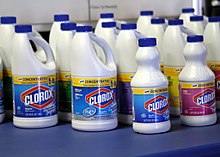
Back Bleikmiddel Afrikaans Leixiva AN ماء جافيل Arabic Жавель Byelorussian বিরঞ্জক Bengali/Bangla Lleixiu Catalan Жавель шывĕ CV Klorkalk Danish Javelwasser German Χλωρίνη Greek

Bleach is the generic name for any chemical product that is used industrially or domestically to remove color from (i.e. to whiten) fabric or fiber (in a process called bleaching) or to disinfect after cleaning. It often refers specifically to a dilute solution of sodium hypochlorite, also called "liquid bleach".
Many bleaches have broad-spectrum bactericidal properties, making them useful for disinfecting and sterilizing. They are used in swimming pool sanitation to control bacteria, viruses, and algae and in many places where sterile conditions are required. They are also used in many industrial processes, notably in the bleaching of wood pulp. Bleaches also have other minor uses, like removing mildew, killing weeds, and increasing the longevity of cut flowers.[1]
Bleaches work by reacting with many colored organic compounds, such as natural pigments, and turning them into colorless ones. While most bleaches are oxidizing agents (chemicals that can remove electrons from other molecules), some are reducing agents (that donate electrons).
Chlorine, a powerful oxidizer, is the active agent in many household bleaches. Since pure chlorine is a toxic corrosive gas, these products usually contain hypochlorite, which releases chlorine. "Bleaching powder" usually refers to a formulation containing calcium hypochlorite.[citation needed]
Oxidizing bleaching agents that do not contain chlorine are usually based on peroxides, such as hydrogen peroxide, sodium percarbonate, and sodium perborate. These bleaches are called "non-chlorine bleach", "oxygen bleach", or "color-safe bleach".[2]
Reducing bleaches have niche uses, such as sulfur dioxide, which is used to bleach wool, either as gas or from solutions of sodium dithionite,[3] and sodium borohydride.
Bleaches generally react with many other organic substances besides the intended colored pigments, so they can weaken or damage natural materials like fibers, cloth, and leather, and intentionally applied dyes, such as the indigo of denim. For the same reason, ingestion of the products, breathing of the fumes, or contact with skin or eyes can cause bodily harm and damage health.
- ^ "12 Smart Ways to Use Bleach - Reader's Digest". 9 March 2010.
- ^ "Oxygen Bleach Vs. Chlorine Bleach". Sciencing. Retrieved 16 April 2018.
- ^ Phillips, H. (2008). "The Bleaching of Wool with Sulphur Dioxide and with Solutions of Sulphites". Journal of the Society of Dyers and Colorists. 54 (11): 503–512. doi:10.1111/j.1478-4408.1938.tb01992.x.